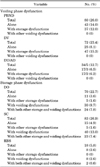Abstract
Purpose
Materials and Methods
Results
Figures and Tables
 | FIG. 1Change in incidence of each specific urodynamic etiology according to patient age. (A) Voiding phase dysfunction, (B) storage phase dysfunction. Among the total patient population, the incidence of PBND was highest among those in their 30s (p=0.04) and that of DO was highest among those in their 40s (p=0.03). SC was more prevalent in men under 40 years of age (p=0.03). PBND, primary bladder neck dysfunction; DV, dysfunctional voiding; DU, detrusor underactivity; AD, acontractile detrusor; DV, dysfunctional voiding; DU, detrusor underactivity; AD, acontractile detrusor; DO, detrusor overactivity; SC, small bladder capacity; RBS, reduced bladder sensation. |
TABLE 1

Seventy-nine patients (25.6%) had normal urodynamic findings. Low bladder compliance (≤20 mL/cm H2O) was found in 16 patients and all these cases were associated with voiding phase or storage phase urodynamic dysfunctions.
PBND, primary bladder neck dysfunction; DV, dysfunctional voiding; DU, detrusor underactivity; AD, acontractile detrusor; DO, detrusor overactivity; SC, small bladder capacity; RBS, reduced bladder sensation.
TABLE 2

Values are presented as mean±standard deviation or number (%).
PBND, primary bladder neck dysfunction; DV, dysfunctional voiding; DU, detrusor underactivity; AD, acontractile detrusor; Qmax, maximum flow rate; PVR, postvoid residual; MUCP, maximum urethral closing pressure; CMG, cystometry; DO, detrusor overactivity; Pdet open, opening detrusor pressure; PdetQmax, detrusor pressure at maximum flow rate.
a-c: The same superscript alphabet indicate nonsignificant difference.
TABLE 3

Values are presented as mean±standard deviation or number (%).
DO, detrusor overactivity; SC, small bladder capacity; RBS, reduced bladder sensation; Qmax, maximum flow rate; PVR, postvoid residual; MUCP, maximum urethral closing pressure; CMG, cystometry; Pdet open, opening detrusor pressure; PdetQmax, detrusor pressure at maximum flow rate.
a:Men with only a single urodynamically defined storage phase dysfunction were selected regardless of coexistence of voiding phase dysfunction in order to contrast findings among each storage phase dysfunction. Therefore, 29 men with DO, 28 men with SC, and 2 men with RBS were excluded from Table 1. a-c: The same superscript alphabet indicate nonsignificant difference.
TABLE 4

PBND, primary bladder neck dysfunction; DV, dysfunctional voiding; DO, detrusor overactivity; DU, detrusor underactivity; AD, acontractile detrusor; LUTS, lower urinary tract symptoms; CP, chronic prostatitis; CPPS, chronic pelvic pain syndrome; VUDS, video-urodynamic study; Qmax, maximum flow rate; OAB, overactive bladder syndrome; BPH, benign prostatic hyperplasia; EPS, expressed prostatic secretion; VCUG, voiding cystourethrography.
a:84.2% of men with DO had other storage phase or voiding phase dysfunctions in urodynamic evaluation.




 PDF
PDF ePub
ePub Citation
Citation Print
Print


 XML Download
XML Download